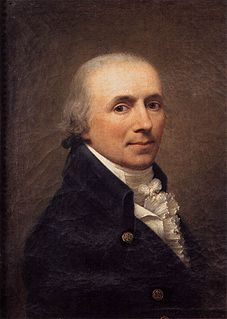Francesco Gasparini was an Italian Baroque composer and teacher whose works were performed throughout Italy, and also on occasion in Germany and England.

Vincenzo Camuccini was an Italian painter of Neoclassic histories and religious paintings. He was considered the premier academic painter of his time in Rome.

Gaspare Traversi was an Italian Rococo painter best known for his genre works. Active mostly in his native city of Naples, he also painted throughout Italy, including a stay in Parma.

Gaspare Diziani was an Italian painter of the late-Baroque or Roccoco period, active mainly in the Veneto but also in Dresden and Munich.
Giuseppe Bastiani was an Italian painter active in the Renaissance period, mainly in his hometown of Macerata. He was a disciple of Gaspare Gasparini. He painted frescoes in the church of Santa Maria Assunta, Arrone.

Gaspare Landi was an Italian painter of the Neoclassic period, active in Rome and his native city of Piacenza.
Gasparo Sacchi, also known as Gaspare da Imola, was an Italian painter of the Renaissance period.
Kaspar Anton von Baroni-Cavalcabo or Gaspare Antonio Cavalcabò Baroni was an Italian painter in a late Baroque period and style. During the greater part of his life he lived in Sacco, where he died. Many of his drawings are in the Library at Innsbruck.

Giuseppe Diotti was an Italian painter of the Neoclassic style.

Juan Antonio Bouzas was a Spanish painter of the Baroque period. He was born at Santiago de Compostela. He was a pupil of Luca Giordano at Madrid. The troubles occasioned by the war of the succession obliged him to withdraw himself from Madrid, and he returned to his native city. His principal works are in the churches at Santiago. In the cathedral is a picture of St. Paul and St. Andrew, and in the convent of the Dominicans are two altar-pieces by him. He painted easel pictures which bear a resemblance to those of his master.
Carlo Cozza was an Italian painter, the son of Giovanni Battista Cozza (1676-1742). He was born and died in Ferrara. He trained under his father, and painted mainly for the churches of his native city. In the Chiesa Nuova is a picture by him of the Annunciation; in the church of Santa Lucia of 'St. Anthony the Abbot; and in San Matteo of 'St. Francis of Paola’‘.

Jacopo Marieschi (1711–1794) was an Italian painter of Vedute and also figure painting, active in his native Venice.

Battista del Moro was an Italian painter of the Renaissance period active in his native Verona, as well as in Mantua and Venice.

Vincenzo Ansaloni was a native of Bologna, and a disciple of Lodovico Carracci. Under so able an instructor he became a reputable painter of history. Malvasia speaks in very favourable terms of an altar-piece by this master, in the chapel of the family of Fioravanti, in the church of Santo Stefano of Bologna, representing the 'Martyrdom of St. Sebastian.' His main work is a picture in the church of the Celestine Monks, representing the Virgin Mary with the Infant Saviour in the clouds, and below, St Roch and St Sebastian. According to Zani, he flourished about 1615, and died young.
Robert van Audenaerde or Ouden-Aerd (1663–1748) was a Flemish painter and engraver.

Sigismondo Caula (1637–1724) was an Italian painter of the Baroque style.

Charles-Laurent Maréchal was a French painter.
Gaspare Mattioli (1806–1843) was an Italian painter who worked in a Neoclassical style.
Michele Blasco (1607–1661) was an Italian painter and architect, active in his native Sicily, mainly painting in sacred subjects in a Baroque style.
Macerata Cathedral is a Renaissance-style, Roman Catholic cathedral dedicated to the St Julian in the town of Macerata, province of Macerata, region of Marche, Italy.
The public domain consists of all the creative works to which no exclusive intellectual property rights apply. Those rights may have expired, been forfeited, expressly waived, or may be inapplicable.

Michael Bryan was an English art historian, art dealer and connoisseur. He was involved in the purchase and resale of the great French Orleans Collection of art, selling it on to a British syndicate, and owned a fashionable art gallery in Savile Row, London. His book, Biographical and Critical Dictionary of Painters and Engravers, first published in 1813-16, was a standard reference work throughout the 19th century, and was last republished in 1920; however it is now badly outdated.














